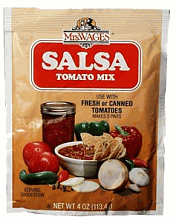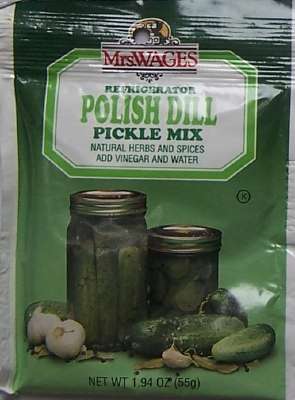
Looking for Orange Juice: How to make and bottle your own homemade canned orange juice in 2025? Scroll down this page and follow the links. And if you bring home some fruit or vegetables and want to can, freeze, make jam, salsa or pickles, see this page for simple, reliable, illustrated canning, freezing or preserving directions. There are plenty of other related resources, click on the resources dropdown above. If you are having a hard time finding canning lids, I've used these, and they're a great price & ship in 2 days.
If you have questions or feedback, please let me know! There are affiliate links on this page. Read our disclosure policy to learn more.
Orange Juice: How to make and bottle your own homemade canned orange juice
How to Make Homemade, Home-canned Orange Juice
Making and canning your own orange juice is
easy. Here's how to make your own home canned citrus juice,
complete instructions in easy steps and completely illustrated. The
orange juice will taste MUCH better than anything you've ever had
from a store.
Prepared this way, the jars have a shelf life of 18 months to 2 years, and require no special attention.
Directions for Making Orange Juice
Ingredients
- Oranges (see step 1)
Equipment
- Jar grabber (to pick up the hot jars)
- Lid lifter (I like the lid rack that holds 12 lids or you can pull them out one at a time with the lid-lifter that has a magnet from the almost-boiling water where you sanitize them. ($4 at mall kitchen stores and local "big box" stores, but it's usually cheaper online from our affiliates)t)
- Jar funnel ($4 at mall kitchen stores and local "big box" stores, but it's usually cheaper online from our affiliates)t)
- At least 1 large pot (at least 8-quart size or larger)
- Large spoons and ladles,
- Canning jars (often called Ball jars, Mason jars or Kerr jars) (Publix, Kroger, other grocery stores and some "big box" stores carry them - now about $12 per dozen quart jars (up 50% in 2 years!) including the lids and rings)
- Sieve:
- a simple metal or plastic sieve.
- colander
- Filters - if you want filtered juice
- jelly bag
- cheesecloth
- coffee filters
- 1 water bath canner (a huge pot with a lifting rack to sanitize the jars of orange juice after filling (about $30 to $35 at mall kitchen stores and local "big box" stores, but it's usually cheaper online from our affiliates) You CAN use a large pot instead, but the canners are deeper, and have a rack top make lifting the jars out easier. If you plan on canning every year, they're worth the investment.
Recipe and Directions
Step 1 - Selecting the oranges
The most important step! You should choose the best oranges you can get and make far better orange juice. Don't get me wrong, it is fine to use small oranges and less attractive varieties, as long as they are firm and unspoiled!
Step 2 - How many oranges and where to get them
You can pick your own, or buy them at the grocery store. But for large quantities, you will find that real* farmer's markets, like the Farmer's Market in Forest Park, Georgia have them at the best prices. In 2004, they were available from late September at $11 to $16 per bushel. 2005 prices have been in the $14 to $20 range at the real farmer's markets, like the Atlanta-Forest park Georgia State Farmer's Market and orchards in the southeast of the U.S.
You will get about 12 to 20 quarts of orange juice per bushel of oranges. Count on 15 or 16 quarts per bushel.
* - not the cutesy, fake farmer's markets that are just warehouse grocery stores that call themselves farmer's markets.which develop standing waves like those ones I talked about for a long string or piano string, but that our metaphors, if you will, for the allowed states of an electron in an admin. So we're going to see a lot of administrations. We're going to see mathematics, and we're going to come to understand the basic principle of physics and how they explain a whole host of both natural and technological phenomena. And, more importantly, how they lay the fundamental groundwork for our understanding of the entire universe. Now, before. we start.
 Step
3 - Wash the jars and lids
Step
3 - Wash the jars and lids
Now's a good time to get the jars ready, so you won't be rushed later. The dishwasher is fine for the jars; especially if it has a "sanitize" cycle, the water bath processing will sanitize them as well as the contents! If you don't have a dishwasher with a sanitize cycle, you can wash the containers in hot, soapy water and rinse, then sanitize the jars by boiling them 10 minutes, and keep the jars in hot water until they are used. Leave the jars in the dishwasher on "heated dry" until you are ready to use them. Keeping them hot will prevent the jars from breaking when you fill them with the hot orange juice.
Put the lids into a pan of hot, but not quite boiling water (that's what the manufacturer's recommend) for 10 minutes, and use the magnetic "lid lifter wand" to pull them out.
Step 4 -Wash and peel the oranges or oranges!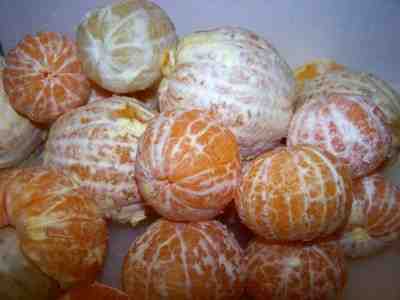
I'm sure you can figure out how to wash the fruit in plain cold water. If you have a juicer or squeezer, it obviously makes it much easier. If you don't have a juicer, don't fret, just peel the fruit (as shown in the photo), then chop or crush the fruit with a potato masher and continue to the next step.
See here for related tools, equipment, supplies on Amazon See here for related tools, equipment, supplies on Amazon See here for related tools, equipment, supplies on Amazon
Step 5 - Briefly, quickly cook the oranges
Pretty simple put about 2 inches of water (I used filtered tap water)
on the bottom of a huge, thick-bottomed pot. Put the lid on, and the heat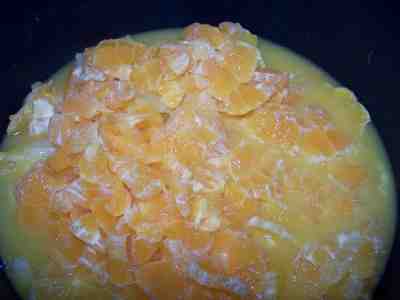 on high. When it gets really going, turn it off - you only want to
release the juice from the pulp.. Obviously, if you used a juicer, you can
skip this step and step 6.
on high. When it gets really going, turn it off - you only want to
release the juice from the pulp.. Obviously, if you used a juicer, you can
skip this step and step 6.
Hardware stores sell a fruit steamer. I haven't used one yet, but I hear they work well.
Step 6 - Sieve the cooked oranges
Now you want to separate the liquid from the pulp, skins, seeds, stems, etc. There are quite a variety of ways to filter the oranges.
Unfiltered juice:
- I like a natural orange juice, with the natural cloudiness of the fruit particles in it, so I just plop the cooked oranges into a large metal or plastic sieve or colander.
- You can also refrigerate the juice for 24 to 48 hours and then decant it (without mixing, carefully pour off clear liquid and discard sediment).
Filtered juice:
- A better way if you want filtered orange juice is just to line your sieve or colander with several layers of cheese cloth and let the juice drip through. It could take an hour..
- If you want really clear orange juice (but most people prefer "natural" style with some solids) you can strain the juice through a paper coffee filter place inside a sieve or colander.
- If you want more filtered orange juice, use a jelly bag. Just pour hot prepared fruit pulp into a jelly bag and let it drip. . Do not squeeze the bag.! In my experience this method takes forever.
Note: One of the easiest ways to extract juice is by using a steam juicer available at many hardware and variety stores. If you plan on making a lot of juice or doing this every year, it may be worth buying one. This unique piece of equipment allows you to conveniently extract juice by steaming the fruit which is held in a retaining basket. The juice drops into a reservoir which has a tube outlet for removal. Follow manufacturer's instructions for using steam juicer.
If your goal is to make orange juice, you will still have a lot of orange pulp left, so I'd recommend you make orange curd from it (see this page)
Step 7 - Heat the orange juice
Put the orange juice into a large pot.
The orange juice does not need any further cooking; just get it heated to steaming hot, around 195 F, not actually boiling, and keep it hot until you get enough made to fill the jars you will put into the canner (Canners hold seven jars at once, whether they are quart or pint size)
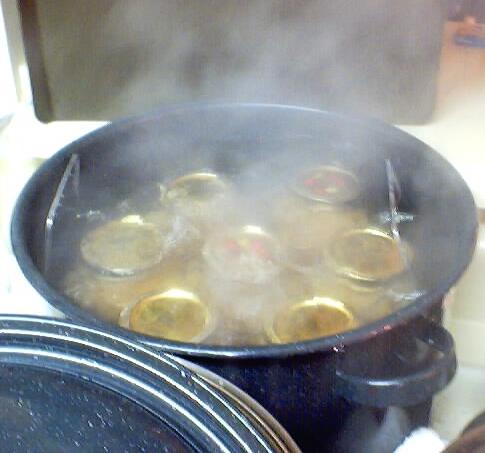 Step
8 - Fill the jars and process them in the water bath
Step
8 - Fill the jars and process them in the water bath
Fill them to within 1/4-inch of the top, wipe any spilled orange juice of the top, seat the lid and tighten the ring around them. Put them in the
canner and keep them cover with at least 1 or 2 inches of water and boiling. Boil pint or quart
jars for 15 minutes min. This assumes you kept the juice hit until you filled the jars. Recommended process time for
Lemon Juice in a boiling-water canner.
Process Time at Altitudes of
Style of Pack
Jar Size
0 - 1,000 ft
Hot
Pints or Quarts
15 min
Step 9 - Remove and cool the jars - Done
Lift the jars out of the water and let them cool without touching or bumping them in a draft-free place (usually takes overnight) You can then remove the rings if you like, but if you leave them on, at least loosen them quite a bit, so they don't rust in place due to trapped moisture. Once the jars are cool, you can check that they are sealed verifying that the lid has been sucked down. Just press in the center, gently, with your finger. If it pops up and down (often making a popping sound), it is not sealed. If you put the jar in the refrigerator right away, you can still use it. Some people replace the lid and reprocess the jar, then that's a bit iffy. If you heat the contents back up, re-jar them (with a new lid) and the full time in the canner, it's usually ok.
Other Equipment:
- Jar lifting tongs to pick up hot jars
- Lid lifter - to remove lids from the pot of boiling water (sterilizing )
- Lids- disposable - you may only use them once
- Ring - holds the lids on the jar until after the jars cool - then you remove them, save them and reuse them
- Canning Jar funnel - to fill the jars
 Granite Ware 21 QT, 9 Piece Enamelware Water bath Canning Pot with Canning kit, Colander and Rack VKP Brands Water Bath AND Steam Canner, 20 Quart Stainless Steel, flat-bottomed Induction range compatible and safe for smooth top ranges. 
|
Home Canning KitsSee the seller's website for more information, features, pricing and user reviews! This is the same type of standard canner that my grandmother used
to make everything from orange juice to jams and jellies to tomato and
spaghetti sauce. This complete kit includes everything you need: the
canner, jar rack, Jar grabber tongs, lid lifting wand, a plastic funnel,
labels, bubble freer, and the bible of canning, the Ball Blue Book. You will never need anything else except more jars and lids! |
| See here for related tools, equipment, supplies on Amazon |
Norpro 1951 Manual Food Strainer, with optional motor; (almost identical to Victorio V250, Villaware and Roma models, all discontinued)
See the seller's website for more information, features, pricing and user reviews! |
| See here for related tools, equipment, supplies on Amazon |
Deluxe Food Strainer and Sauce MakerA food strainer allows you to easily make smooth tomato sauces, seedless jams and jellies, applesauce, soups, baby foods, and much more. The strainers can use different sized screens to filter out different sized seeds and debris. There are both hand cranked and motorized versions.
|
Lids, Rings, Jars, mixes, pectin, etc.Need lids, rings and replacement jars? Or pectin to make jam, spaghetti sauce or salsa mix or pickle mixes? Get them all here, and usually at lower prices than your local store! |
Looking for canning equipment and supplies?
Water bath canner with a jar rack
Pressure canners for gas, electric and induction stoves: Presto 23Qt or T-fal 22Qt
Canning scoop (this one is PERFECT)
Ball Blue book (most recent version)
Jars: 8oz canning jars for jams
Find Other types of farms:
Farm markets and roadside stands
Road trips and camping resources
Local Honey, apiaries, beekeepers
Consumer fraud and scams information
Home canning supplies at the best prices on the internet!
Maple Syrup Farms, sugarworks, maple syrup festivals
Environmental information and resources
Farms For Your Event for birthday parties, weddings, receptions, business meetings, retreats, etc.
Festivals - local fruit and vegetable festivals
Get the
most recent version of
the Ball Blue Book
With this Presto 23 quart pressure canner and pressure cooker, you can "can" everything, fruits, vegetables, jams, jellies, salsa, applesauce, pickles, even meats, soups, stews. Model 01781

You can make jams, jellies, can fruit, applesauce, salsa and pickles with water bath canners, like this Granite Ware 12-Piece Canner Kit, Jar Rack, Blancher, Colander and 5 piece Canning Tool Set



